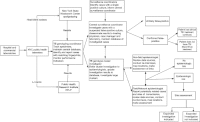Universal genotyping in tuberculosis control program, New York City, 2001-2003
- PMID: 16704826
- PMCID: PMC3374450
- DOI: 10.3201/eid1205.050446
Universal genotyping in tuberculosis control program, New York City, 2001-2003
Abstract
In 2001, New York City implemented genotyping to its tuberculosis (TB) control activities by using IS6110 restriction fragment length polymorphism (RFLP) and spoligotyping to type isolates from culture-positive TB patients. Results are used to identify previously unknown links among genotypically clustered patients, unidentified sites of transmission, and potential false-positive cultures. From 2001 to 2003, spoligotype and IS6110-based RFLP results were obtained for 90.7% of eligible and 93.7% of submitted isolates. Fifty-nine (2.4%) of 2,437 patient isolates had false-positive culture results, and 205 genotype clusters were identified, with 2-81 cases per cluster. Cluster investigations yielded 57 additional links and 17 additional sites of transmission. Four additional TB cases were identified as a result of case finding initiated through cluster investigations. Length of unnecessary treatment decreased among patients with false-positive cultures.
Figures


References
-
- Valway SE, Richards SB, Kovacovich J, Greifinger RB, Crawford JT, Dooley SW. Outbreak of multi-drug-resistant tuberculosis in a New York State prison, 1991. Am J Epidemiol. 1994;140:113–22. - PubMed
-
- Coronado VG, Beck-Sague CM, Hutton MD, Davis BJ, Nicholas P, Villareal C, et al. Transmission of multidrug-resistant Mycobacterium tuberculosis among persons with human immunodeficiency virus infection in an urban hospital: epidemiologic and restriction fragment length polymorphism analysis. J Infect Dis. 1993;168:1052–5. 10.1093/infdis/168.4.1052 - DOI - PubMed
MeSH terms
LinkOut - more resources
Full Text Sources
Medical
